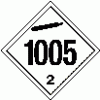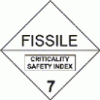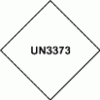TDG
- TDG Home
- TDG Directorate
- Emergency Response Task Force
- CANUTEC
- TDG Act
- TDG Regulations
- Protective Directions
- Interim Orders
- Consultation
- Containers
- Equivalency Certificates (Permits)
- Emergency Response Assistance Plans
- Safety Awareness Materials and FAQ
- TDG Publications
- Enforcement Actions Summaries
- TDG Security
- Training
- Contraventions
- TDG Contact Us / Contacts
- Links
- TDG Site Map
Regulations amending the TDG Regulations
Summary of Amendment No. 6
Transport Dangerous Goods Directorate
Changes brought forward by Amendment No. 6 of the Transportation of Dangerous Goods Regulations came into force on February 20, 2008.
The amendments affect :
- 12 of the 16 Parts
- The three Schedules
Part 1 — Coming into Force, Repeal, Interpretation, General Provisions and Special Cases
Changes to Interpretation
Section 1.3 :
- Placard (the singular includes the plural )
- ‘or' is inclusive, unless otherwise specified
- Copy of the shipping document = the shipping document
- Of the conversion between the number of articles and the net explosives quantity
- Minimum required means of containment
- Gross mass of all dangerous goods (ref: 1.15, 1.16, 1.21 et 1.22)
Safety Standards and Safety Requirement Documents
- Table has been moved to Section 1.3.1
- Reflects the most recent versions of:
- 49 CFR
- CGA P-20
- CGSB-43.147
- CSA B620 / B621 / B622
- ICAO Technical Instructions
- IMDG Code
- UN Recommendations
Definitions
Repealed definitions:
- Water capacity
- Risk group
- Diagnostic specimen
Changed definitions :
- 49 CFR
- Biological product
- Classification
- Consignment
- Gross mass
- ICAO Technical Instructions
- IMDG Code
- Infectious substance
- Large means of containment
- Manual of Tests and Criteria
- Net explosives quantity
- Person
- Road vehicle
- Small means of containment
- Supplement to the ICAO Technical Instructions
- Road vehicle
New definitions :
- Capacity
- Farming
- Culture
- Farmer
- Category A
- Type 1A means of containment
- Drum
- Type 1B means of containment
- Category B
- Type 1C means of containment
General Provisions
Section 1.5
- Include Section 1.48 in this Section
- Addition of Sections 1.5.1 and 1.5.2 to specify the applicability of :
- Schedule 2, Special Provisions
- Schedules 1 and 3 for forbidden dangerous goods
Section 1.6
- New text to differentiate and specify the requirements particular to columns 8 and 9 of Schedule 1.
Special Cases
- Twenty-five special cases amended
- Eleven new special cases
- One special case removed
Removal of almost all of the expressions “These Regulations do not apply to…”
This expression is replaced with different wording that indicates which parts do not apply.
Section 1.15
- 150 kg Gross Mass Exemption
Section 1.16
- 500 kg Gross Mass Exemption
Section 1.17
- Limited Quantities Exemption
Section 1.18
- Medical Device or Article
Section 1.19
- Samples for Inspections or Investigation Exemption
Section 1.19.1
- Samples Classifying, Analysing or Testing Exemption
Section 1.19.2
- Samples Demonstration Exemption
Section 1.21
- Agriculture: 1500 kg Farm Vehicle Exemption
Section 1.22
- Agriculture: 3000 kg Gross Mass Retail Exemption
Section 1.23
- Agriculture : Pesticide Exemption
Section 1.24
- Agriculture: Anhydrous Ammonia Exemption
Section 1.26
- Emergency Response Exemption
Section 1.27
- Operation of a Means of Transport or a Means of Containment Exemption
Section 1.28
- Transportation between two Properties
Section 1.29
- Dangerous goods in an Instrument or in Equipment
Section 1.30
- Marine: Short-run Ferry Exemption
Section 1.31
- Class 1, Explosives Exemption
Section 1.32
- Class 2, Gases, in Refrigerating Machines Exemption
Section 1.32.1
- Class 2, Gases, That May Be Identified as LIQUEFIED PETROLEUM GAS, UN1075
Section 1.32.2
- Gases, Absolute Pressure between 101.3 kPa and 280 kPa
Section 1.32.3
- Class 2, Gases, in Small Means of Containment Exemption
Section 1.33
- Class 3, Flammable Liquids, General Exemption
Section 1.34
- Class 3, Flammable Liquids, Flash Point Greater Than 60°C but Less Than or Equal to 93°C
Section 1.34.1
- GASOLINE, UN1203, to operate an Instrument or Equipment Exemption
Section 1.35
- DIESEL FUEL, UN1202, or GASOLINE, UN1203, Exemption
Section 1.36
- Class 3, Flammable Liquids, Alcoholic Beverage and Aqueous Solution of Alcohol Exemption
Section 1.38
- Polyester Resin Kit Exception
Section 1.39
- Class 6.2, Infectious Substances, Category B Exemption
Section 1.41
- Biological Products Exemption
Section 1.42
- Human or Animal Specimens Believed Not to Contain Infectious Substances Exemption
Section 1.42.1
- Tissues or Organs for Transplant Exemption
Section 1.42.2
- Blood or Blood Components Exemption
Section 1.43
- Class 7, Radioactive Materials Exemption
Section 1.44
- Dangerous Goods in a Drum Exemption
Section 1.45.1
- Marine Pollutants Exemption
Section 1.47
- FIRE EXTINGUISHERS, UN1044, Exemption
Section 1.48
- Air Ambulance Exemption
Part 2 — Classification
- Change in the maximum value of the flash point for the classification of flammable liquids, from 60.5oC to 60oC
- Category A and Category B are replacing risk groups for infectious substances of Class 6.2.
- New approach to classifying :
- Class 7, Radioactive Materials
- Class 9, Miscellaneous Products, Substances or Organisms
- Amendments to the Schedules of this Part to:
- Change the description of Compatibility Groups, Class 1, Explosives
- Incorporates a guide for the assignment of Category A or Category B to infectious substances
Part 3 — Documentation
- Allows the following information to be recorded under one heading :.
- Subsidiary class or classes
- Packing group
- The requirement to record the risk group is eliminated.
- It is now possible to use a unit of measure that is acceptable under the International System of Units to express the quantity of DGs being transported. For example: 1 t = 1000 kg .
- The number of small means of containment must now be recorded for all classes being transported.
Part 4 — Dangerous Goods Safety Marks
- The option of leaving the DANGER placard on a large means of containment when it is no longer required has been moved to Section 4.9.
- The UN number that must appear on a large means of containment must be black and not less than 65 mm high.
- The person responsible for the means of containment is now responsible for changing or removing the safety marks.
- An interconnected combination of cylinders (each with a capacity greater than 225 L) can be placarded as one large means of containment.
- The shipping name must be displayed in cases where a primary class label must be displayed on a small means of containment.
- The display of a placard is now required on a large means of containment for certain explosives
- having a net explosives quantity exceeding 10 kg or
- having a number of articles exceeding 1000.
- The placard and the UN number of a means of containment within which is a means of containment that requires a placard must be displayed on both large means of containment.
- The table in Section 4.15 has also been changed.
- new rules concerning the display of a DANGER placard in items 3 and 4 of the table.
- The requirements in Section 4.18 concerning mixed loads of Class 2, Gases have been changed.
- A large means of containment transporting Anhydrous Ammonia, UN1005 must display :
- A Class 2.2 or 2.3 placard or Anhydrous Ammonia placard until August 31, 2008
- A Class 2.3 or Anhydrous Ammonia placard as of August 31, 2008
Addition of three new safety marks :
Placard and label, Class 2.3(8), Anhydrous Ammonia
Label, Class 7, Fissile Radioactive materials
Class 6.2, Category B Biological products mark
Part 5 — Means of containment
- The explosives compatibility groups table has been changed :
- Compatibility between groups B and S has been added.
- Section 5.9 has been eliminated :
- The Explosives Vehicle Certificate (EVC) will soon be abolished by Natural Resources Canada.
- New requirements concerning :
- Cylinders or tubes containing Class 2, Gases
- Class 6.2, Infectious Substances
- Tank trucks and certain portable tanks selected in accordance with CSA B621 and B622 manufactured and used in Canada after August 31, 2008 will have to be manufactured in accordance with CSA B620.
- They will also have to be tested and inspected in accordance with CSA B620 when the most recent periodic re-test or periodic inspection is performed in Canada on or after August 31, 2008.
Part 7 — Emergency Response Assistance Plan
- Only Section 7.1 has been changed.
- Now has nine paragraphs rather than seven
- New way to calculate quantities requiring an ERAP.
- Two new situations requiring an ERAP
- Transport, by rail (interconnected tank cars), of certain Class 3, Flammable Liquids
- Transport of certain Class 6.2, Category B infectious substances
- The requirements about authorization to use another person's ERAP have been changed. The ERAP may only be used if:.
- The DGs originate outside Canada and are being transported through Canada to a destination outside Canada.
- The DGs are being returned to the manufacturer or producer.
- A new paragraph has been added to specify that :
- A person who offers for transport or imports dangerous goods remains responsible for emergency response assistance .
- Substances classified in accordance with Part 2 of the TDG Regulations requiring an ERAP must have an ERAP even if they are classified in accordance with :
- ICAO Technical Instructions
- IMDG Code
- UN Recommendations
Part 8 — Accidental Release and Imminent Accidental Release Report Requirements
- Reporting requirements have been changed for the following substances :
- Class 1, Explosives
- Class 6.2, Infectious Substances
- A person in possession of DGs must now immediately report to CANUTEC for DGs of Class 1, Explosives.
Part 9 — Road
- New requirements for trans-border movements :
- Labels and placards for Classes 2.3 and 6.1, when required, must be those of Part 4, of the TDG Regulations
- Reciprocity does not apply when exceptions from displaying DG safety marks or for packaging requirements exist in the U.S. but are not authorized in Canada
- The description of the DGs on the shipping document
- Clarifications specifying requirements of displaying placards for DGs being transported on a road vehicle from an air or marine transport mode.
- New requirements for assessing net explosives quantity.
- There is no reciprocity for packaging
Part 10 — Rail
- New requirements for trans-border movements :
- Labels and placards for Classes 2.3 and 6.1, when required, must be those of Part 4, of the Canadian TDG Regulations
- Reciprocity does not apply when exceptions from displaying DG safety marks or for packaging requirements exist in the U.S. but are not authorized in Canada
- The description of the DGs on the shipping document
- Clarifications specifying requirements of displaying placards for DGs being transported on a road vehicle from an air or marine transport mode
- The prohibition on transporting by railway vehicle a tank truck that contains DGs has been removed.
- New requirements on the location of railway vehicles transporting DGs in a train.
- A table has been added in order to better describe the requirements on coupling of railway vehicles.
- New inspection requirements regarding owners of railway vehicles that have received a report.
Part 11 — Marine
- Minor changes have been made in order to clarify certain requirements.
- Henceforth, Section 5.11, Aerosol Containers for Class 2, Gases, of the TDG Regulations is a requirement that must be complied with for international transport and transport during a home-trade voyage, Class 1.
Part 12 — Air
- Several changes made to this Part modify the wording in order to reflect the terms that have been changed in Part 1 of the TDG Regulations.
- Shipping Document :
- Must contain the information required by the ICAO Technical Instructions.
- Must have, on the left and right margins, red hatchings that are oriented to the right or to the left.
- The IATA shipper's declaration is no longer required.
- Safety aboard an aircraft :
- A law enforcement officer or a security guard on board may carry a loaded firearm.
- The exemption concerning the transport of infectious or toxic substances has been changed :
- The expression “risk group” has been removed.
- Certain infectious substances are no longer part of this exemption.
- The following exemptions have been moved to Part 1 of the Regulations :
- Air Ambulance, see Section 1.48.
- Emergency Response, see Section 1.26.
Part 16 — Inspectors
- Three new sections have been created to introduce requirements regarding :
- the detention of dangerous goods or means of containment
- directions to remedy non-compliance
- directions not to import or to return to place of origin
- Copies of related documents have been inserted in the Regulations.
Schedule 1, Classes 1 to 9
- The heading of column 4 has been changed (Category instead of Risk Group)
- The legends of columns 4 and 6-9 have been changed.
- The classification of ANHYDROUS AMMONIA, UN1005 has been changed to Class 2.3(8), Gases.
- A few changes in the index, such as that the shipping name of UN1203 in French is now ESSENCE.
- A new substance : ETHANOL AND GASOLINE MIXTURE with more than 10 per cent ethanol, UN3475.
Schedule 2, Special Provisions
- The provisions concerning Explosives Vehicle Certificates have been eliminated because Natural Resources Canada will soon be abolishing this requirement.
- A few Special Provisions have been added to calculate the net explosives quantity when the true quantity cannot reasonably be determined.
- LIQUEFIED PETROLEUM GASES, UN1075
- Special Provision 29 has been moved to section 1.32.1 and changed slightly.
- Certain gases of Class 2
- Special Provision 42 has been moved to section 1.32.3 and changed slightly.
- Explosives
- Special Provision 75 for quantities less or equal to 100 articles for certain explosives has been eliminated.
- New Special Provisions to :
- Exempt certain Class 9 DGs from complying with the requirements of section 5.12 in Part 5, Means of containment.
- Set out the Class 3 DGs (UN1202, UN1203 and UN1863) which require an ERAP in accordance with section 7.1(5) when they are transported on interconnected tank cars.
- Exempt certain Class 3 DGs (glues, inks, paints and resins) from the provisions of section 5.12 in Part 5, Means of containment.
- Set out the infectious DGs (UN2814 and UN2900) which require an ERAP in accordance with section 7.1(6).
- Allow the enforcement of section 1.31 for certain explosives despite the index number in column 6 of Schedule 1 .
- Exempt OXYGEN, REFRIGERATED LIQUID, UN1073 less than or equal to 1 L when it is used for medical purposes (passenger carrying road vehicle or passenger carrying railway vehicle).
- Allow the transportation of certain DGs (UN1202, UN1203 and UN1978) in a passenger carrying road vehicle.
- Set out a transitional period (until January 1st, 2010) to allow the transportation of TAR, UN1999 in small non standard means of containment. Certain conditions apply.
Schedule 3, Alphabetical Index
Some changes have been made, notably the addition of ETHANOL AND GASOLINE MIXTURE with more than 10 per cent ethanol, UN3475.


